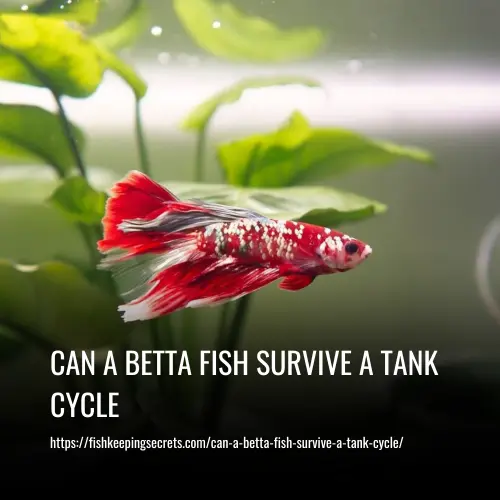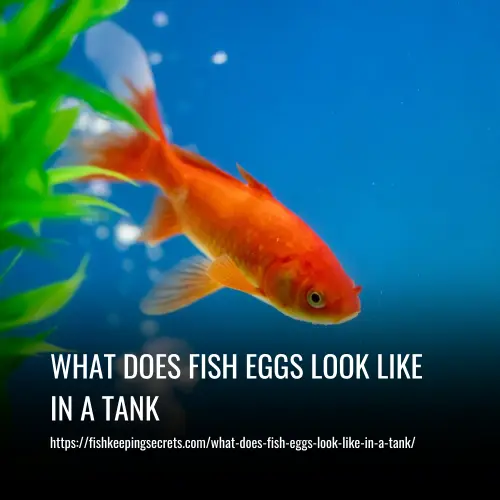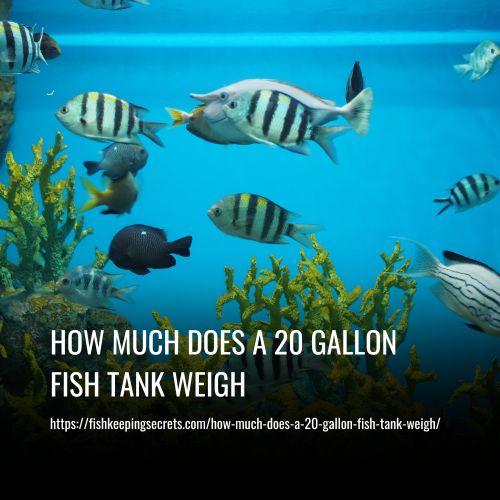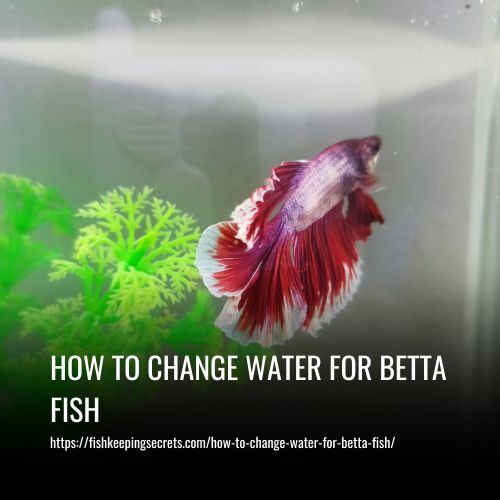How To Tell If Fish Are Happy In New Tank
This post contains affiliate links. As an Amazon Associate, we earn from qualifying purchases.
Fish are happy in a new tank when they swim around actively and eat food regularly. To ensure the well-being of your fish, monitor their behavior closely for the first few weeks in the new environment.
Stress, illness or a lack of essential nutrients may cause fish to feel unhappy or exhibit abnormal behavior. Therefore, it’s crucial to maintain a healthy environment in the tank by regularly cleaning the water and providing the required food, plants and hiding places. A happy and healthy fish tank can add vibrancy and tranquility to your living space.
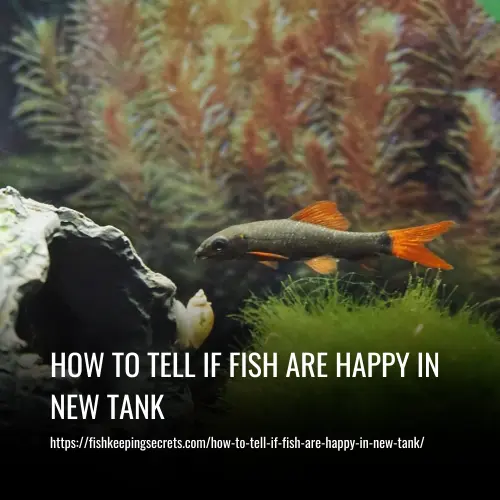
The Right Water Quality For Thriving Fish
Importance Of Water Quality For Fish Health
Fish are most comfortable and content in a particular environment, and the water quality plays a vital role in their health and happiness. Fish can’t survive in stagnant or contaminated water as it can cause irreparable damage to their health, making them unhappy and stressed.
Therefore it’s essential to maintain healthy water conditions to ensure the well-being of the fish. Here are a few reasons why water quality is of utmost importance to ensure fish health:
- Water quality is an integral part of the aquatic ecosystem
- It affects the chemical balance of the aquarium
- Keeps the fish healthy and happy
How To Achieve Ideal Water Parameters
While maintaining a healthy aquarium can seem like a daunting task, proper care and maintenance can help to achieve ideal water parameters. You can achieve healthy water parameters for your fish by following these simple steps:
- Test the water quality before introducing fish to the tank
- Keep the tank clean and maintain the filter system
- Regular water changes can help to improve water quality
- Appropriate fish feeding and stocking
Why Good Water Quality Is An Essential Sign Of Thriving Fish
Healthy and happy fish thrive in their environment and exhibit certain characteristics, and good water quality is one such piece of evidence. Achieving and maintaining good water quality is a significant sign of thriving fish, and here’s why:
- Fish will be active and swim around the tank
- Their fins will be erect and not clamped down
- Fish will have bright and vibrant colors
- They will eat regularly and show no signs of stress or illness
Maintaining good water quality in an aquarium is essential to keep the fish healthy and happy. Careful monitoring of the water quality, proper maintenance and regular testing can help to achieve ideal water parameters and ensure the comfort of the fish.
Healthy Fish Behavior
Normal Fish Behavior
When you bring home new fish for your aquarium, it’s important to know what constitutes normal behavior, so you can recognize when something is off. Healthy, happy fish will exhibit the following behaviors:
- Swimming actively and smoothly around the tank
- Exploring their surroundings and swimming in and out of plants or decorations
- Responding to food by swimming to the surface and eating eagerly
- Showing vivid, bright colors (if common in the species)
- Sometimes chasing each other or displaying a display of aggression in small quantities
If your fish are behaving like this, you can be confident that they are healthy and comfortable in their new home.
How To Recognize Signs Of Stress In Fish
Stress in fish can be a sign of poor health and can even be fatal. So, it’s crucial to quickly recognize the following signs of stress:
- Resting at the bottom or at the surface of the tank for long periods
- Hiding behind plants or decorations instead of exploring
- Loss of appetite
- Faded or discolored skin
- Rapid breathing or gasping at the surface of the water
- Clamped fins (fins held against the body)
If your fish are displaying any of these symptoms, chances are they’re not happy and are stressed in their new environment.
Why Healthy Fish Behavior Is Crucial For Thriving Fish
The reason why healthy fish behavior is so crucial is that it’s a sign of thriving fish. Healthy, happy fish will eat regularly and move around the tank with ease. This behavior indicates that they are happy, comfortable, and are receiving the right level of care and attention.
On the other hand, stressed or sick fish will often hide away and not eat, which can lead to further health problems. It’s also worth noting that if left unattended, this could lead to disease outbreaks, which could ultimately harm all fish in the tank.
Understanding healthy fish behavior and how to recognize signs of stress is vital in monitoring the well-being of your fish. By doing so, you’ll be able to take action to mitigate stress and improve their chances of thriving in their new environment.
Proper Feeding Habits
Aquarium enthusiasts invest a lot of time, money, and effort into creating a peaceful and comfortable environment for their beloved fish. However, it can be challenging to know if your fish are happy or not. One of the essential things to consider is their feeding habits.
We will discuss how to ensure that your fish are being fed correctly.
Fish Dietary Requirements
Fish dietary requirements depend on the species, but they generally require a balanced diet consisting of protein, fat, carbohydrates, fiber, and vitamins. Some fish are herbivorous, while others are carnivorous. Some are omnivorous, meaning that they eat both plants and animals.
It’s crucial to understand what your fish need to prevent malnutrition and stunted growth.
The Importance Of Feeding Fish The Right Amount And Type Of Food
Feeding fish too much can lead to health issues such as constipation, obesity, and poor water quality. On the other hand, feeding fish too little can cause malnutrition and stunted growth. It’s vital to get the balance right and to know how much and how often to feed your fish.
How To Ensure Your Fish Are Being Fed Properly
To ensure your fish are being fed correctly, follow these tips:
- Research your fish species to know their dietary requirements.
- Feed a variety of food to provide a balanced diet.
- Feed small amounts of food 2-3 times a day, rather than one large meal.
- Remove any uneaten food from the tank after 5-10 minutes to prevent overfeeding and contamination.
- Avoid feeding too many treats, such as freeze-dried or live food, as they can be high in fat and protein.
- Do not feed your fish with human food as it may contain spices, salt, or preservatives that are harmful to them.
- Consider investing in an automatic feeder if you are unable to feed your fish consistently.
- Monitor your fish’s behavior and weight to ensure they are healthy and happy.
Proper feeding habits are essential for the health and wellbeing of your fish. By understanding their dietary requirements, feeding the right amount and type of food, and monitoring their behavior and weight, you can ensure that your fish are thriving in their new tank.
Remember to research your fish species to provide the best care possible.
Clean And Well-Maintained Tank
Why Clean Tanks Are Essential
A clean tank is essential to keep your fish healthy and thriving. Here are a few reasons why a clean tank is necessary:
- Waste and debris can quickly build up in a tank, leading to high levels of ammonia and nitrites, which can harm your fish.
- Clean tanks often have a healthy and stable ph level. A higher ph level can kill fish, and a lower ph level can make fish more susceptible to diseases.
- Filthy tanks can harbor harmful bacteria and parasites that can harm your fish.
- A clean tank with good water circulation provides the necessary oxygen your fish need to breathe.
Tank Cleaning And Maintenance
Cleaning and maintaining your tank frequently is significant to ensure the health and happiness of your fish. Below are few tips to keep your tank clean and well-maintained:
- Change 20-25% of the water in your tank every two weeks.
- Use a gravel vacuum or syphon to remove debris and waste from the substrate.
- Clean tank decorations and aquarium walls regularly with a soft brush or sponge.
- Check the water parameters regularly using a water test kit and adjust them if necessary.
- Ensure proper filtration in the tank to remove waste and debris.
How A Clean And Well-Maintained Tank Is Evidence Of Thriving Fish
A clean and well-maintained tank is the key to happy and thriving fish. Here’s why:
- Healthy fish have clear and bright colors and appear active and alert.
- Clean and odor-free water is an indication of a thriving environment for your fish.
- The substrate of the tank remains free from debris and leftover food in a well-maintained tank, which is essential for capering fish.
- Plants and other decorations remain fresh and vibrant in a clean and well-maintained tank, providing an attractive living environment for your fish.
Make sure you maintain a clean and proper environment for your fish to keep them healthy and happy in their new tank.
A Stress-Free Environment
Fish are such a fascinating species that can depict various emotions, including being happy. But how can one tell if a fish is happy in a new tank? It all comes down to creating a stress-free environment. Let’s dive in and explore the importance of reducing stressors for fish thrivingness.
Common Stressors For Fish
Fish can experience stress for various reasons, such as changing their environment. It is essential to note common stressors to create a happy and healthy aquarium. Some common stressors include:
- Poor water quality and temperature fluctuations.
- Overcrowding the tank or placing aggressive fish together.
- Lack of hiding spots and plants for fish to explore and hide.
- Loud and unexpected noises around the aquarium.
How To Create A Stress-Free Environment For Fish
Now that we understand common stressors for fish, it’s vital to know how to create a stress-free environment. Here are some tips:
- Keep the water quality clean and stable, monitor temperature, ph, and nitrate levels regularly.
- Only place fish together that are compatible and compatible with the tank size.
- Add aquarium decor and plants to create hiding spots and natural-like environments.
- Place the aquarium in a quiet area without constant foot traffic or loud noises.
The Importance Of Providing A Stress-Free Environment For Fish Thrivingness
Creating a stress-free environment for fish is crucial to their general well-being. A stressful environment can cause fish to become anxious, depressed, and lead to serious health issues like disease outbreaks. Providing a stress-free environment also improves their eating habits, overall health, and happiness.
Creating a stress-free environment for fish is essential for their thrivingness. By understanding common stressors, implementing tips, and prioritizing their well-being, we can keep our fish friends happy and healthy in their new tank.
Proper Tank Size And Compatibility
Fish keeping can be an incredibly rewarding hobby, but with great reward comes great responsibility. One of the most important factors when it comes to keeping your aquatic friends happy is ensuring that their tank meets their needs. Below, we’ll talk about the two critical elements that make your fish happy–proper tank size and compatibility–and how to ensure that you’re meeting those needs.
The Importance Of Tank Size
The size of your fish’s tank is crucial and can mean the difference between a healthy, happy fish and one that’s unhappy and stressed. Fish that are kept in tanks that are too small can develop health issues that affect their overall wellbeing.
Fish that are stressed due to living conditions can quickly become sick, which can lead to untimely deaths. Therefore, it is vital to make sure that you choose the right size of a tank for your fish species.
How To Choose The Right Tank Size For Your Fish
Choosing the right size tank is essential to keeping your fish healthy and thriving. Here are some tips to think about when choosing the appropriate tank size:
- Research your fish breed to determine their unique tank size necessity.
- Consider the number of fish you have and how much space each fish requires as they grow.
- A good rule of thumb is to have at least one gallon of water per inch of fish.
- Don’t forget to think about the aquarium’s height to ensure that your fish have enough room to swim and breathe.
Compatibility And Its Importance To Thriving Fish
Compatibility refers to the specific needs of each fish and the ability of different species to live together harmoniously. Some fish breeds will happily live in a community tank with other fish, while other breeds require a solitary environment to survive.
When setting up a new tank, it’s essential to research which fish breeds are compatible with each other. Making sure your fish are compatible will lead to a less aggressive environment, healthy social interaction, and less stress overall.
Maintaining the happiness of your fish requires attention to both the tank size and compatibility. Take the time to research your fish breed’s specific needs and make informed decisions about their living environment. A healthy, thriving aquarium is the ultimate goal, and understanding the importance of tank size and compatibility are the first steps to ensuring happy fish.
Beautiful And Vibrant Fish
How Healthy, Thriving Fish Are Beautiful To Look At
Fish that are happy and healthy add to the beauty of your tank. When fish are healthy, they display their beautiful colors and exhibit vibrant movements. A thriving fish in a new tank is what every aquarium hobbyist wants. It is a clear indication that you have done everything right, and the fish feel comfortable in their new environment.
The Importance Of Observing Your Fish’S Color, Shape, And Movement
Observing your fish’s color, shape, and movement is essential to telling if they are happy or not. Some key things to look out for are:
- Color: A healthy fish features strong and vivid colors. If they appear dull or faded, then it could be a sign of stress or disease.
- Shape: Fish that are bloated or have visible wounds may be showing signs of illness or stress.
- Movement: Active and lively fish indicate a healthy environment. If fish are lethargic or inactive, it could indicate a problem with the water quality or temperature.
How To Spot Signs Of Illness Or Disease By Observing Your Fish
It is crucial to know how to spot signs of illness or disease in your fish, as early detection will improve their chances of recovery. Here are some things to look out for:
- Loss of appetite: If your fish suddenly stops eating or appears disinterested in food, it could be a sign of illness.
- Changes in behavior: Make note of changes in the behavior of your fish such as swimming erratically or lying on the bottom of the tank.
- Physical changes: Keep a lookout for physical changes such as strange growths or spots, or anything that looks out of the ordinary.
By watching for these indicators, aquarium hobbyists can quickly identify when their fish might be struggling and take action before it’s too late.
Avoiding Overcrowding
The Dangers Of Overcrowding
Overcrowding is one of the most common mistakes that people make when setting up an aquarium. Many beginner aquarists make the mistake of thinking that the more fish they put into the tank, the better it will look. However, this is not the case, and overcrowding can result in a variety of problems.
Some of these issues include:
- Poor water quality: When there are too many fish in a tank, the waste produced by the fish can quickly build up and lead to poor water quality. As a result, the fish can become stressed, and their health can be compromised.
- Increased risk of disease: Overcrowding can also increase the risk of disease transmission between fish. When fish are packed too closely together, it’s easier for diseases to spread from one fish to another.
- Aggressive behavior: Overcrowding can lead to aggressive behavior among fish. When space is limited, fish may become territorial and fight with one another. This can lead to injuries and stress.
How To Avoid Overcrowding A Tank
To avoid overcrowding your tank, it’s important to consider the size of your aquarium and the needs of the fish you want to keep. Some steps you can take to avoid overcrowding include:
- Research the fish species: Before adding any fish to your tank, research the size and behavior of the species you’re interested in. This will give you a good idea of how many fish can comfortably live in your tank without overcrowding.
- Choose the right tank size: Make sure you purchase an appropriately sized tank for the fish you want to keep. As a general rule, it’s recommended that you allow one gallon of water per inch of fish.
- Consider the activity level of the fish: Some fish are more active than others and require more space to swim around. Take this into consideration when deciding how many fish to add to your tank.
- Monitor your fish: Keep a close eye on your fish to make sure they are not displaying any signs of stress or aggression. If you notice any problems, it may be necessary to remove some of the fish from the tank.
Why Avoiding Overcrowding Is Important For Thriving Fish
Avoiding overcrowding is vital for ensuring that your fish thrive and maintain good health. When fish are overcrowded, they can become stressed, their immune systems can weaken, and their lifespan can be shortened. To ensure that your fish thrive, it’s important to provide them with a suitable environment that meets their needs.
This means maintaining good water quality, providing appropriate space and hiding places, and ensuring that there are no aggressive or stressed fish in the tank. By avoiding overcrowding, you can enjoy a healthy and thriving aquarium for years to come.
FAQs
Your fish will be active and visibly happy if they are in a new tank with good quality water. They may also show interest in their surroundings, be responsive to your presence, and have a healthy appetite. Some breeds may even display brighter colors.
Yes, changing the fish’s tank can cause stress that could manifest itself in abnormal swimming behavior or changes in appetite. However, this stress is short-lived and will usually disappear once the fish has adjusted to the new tank environment.
To make your fish comfortable, ensure that the water temperature matches the recommended °f for their species and that the water quality is optimal. Providing a hiding spot and avoiding overcrowding will also help to reduce stress, making your fish more comfortable in their new environment.
Feed your fish only what they can consume in 2-3 minutes, about 2-4 times a day. Overfeeding can lead to water quality issues and health problems. It’s best to maintain a consistent feeding schedule to help your fish adjust to the new feeding location.
Plants like java fern, anubias, and moss balls are low-maintenance and perfect for beginners. They can also provide shelter to fish and remove excess debris from the water. Make sure to choose plants that grow well in your tank conditions and complement the overall aesthetic.
Conclusion
Based on the observations we made, it’s possible to tell if fish are happy in a new tank. We’ve learned that there are several signs that indicate they are thriving: active swimming, healthy appetite, and vibrant colors. It’s important to note, however, that different species of fish have unique behaviors and preferences, so what works for one may not necessarily work for another.
Thus, it’s paramount to research and understand the individual needs of the fish you intend to keep before making any purchase. As pet owners, we have a responsibility to provide a healthy environment for our beloved aquatic creatures. By following the tips and guidelines we’ve discussed, you’ll be well on your way to providing a happy and healthy home for your fish.
Remember to monitor the water and temperature regularly, provide adequate filtration, and give your fish appropriate space and décor to keep them comfortable and content.

